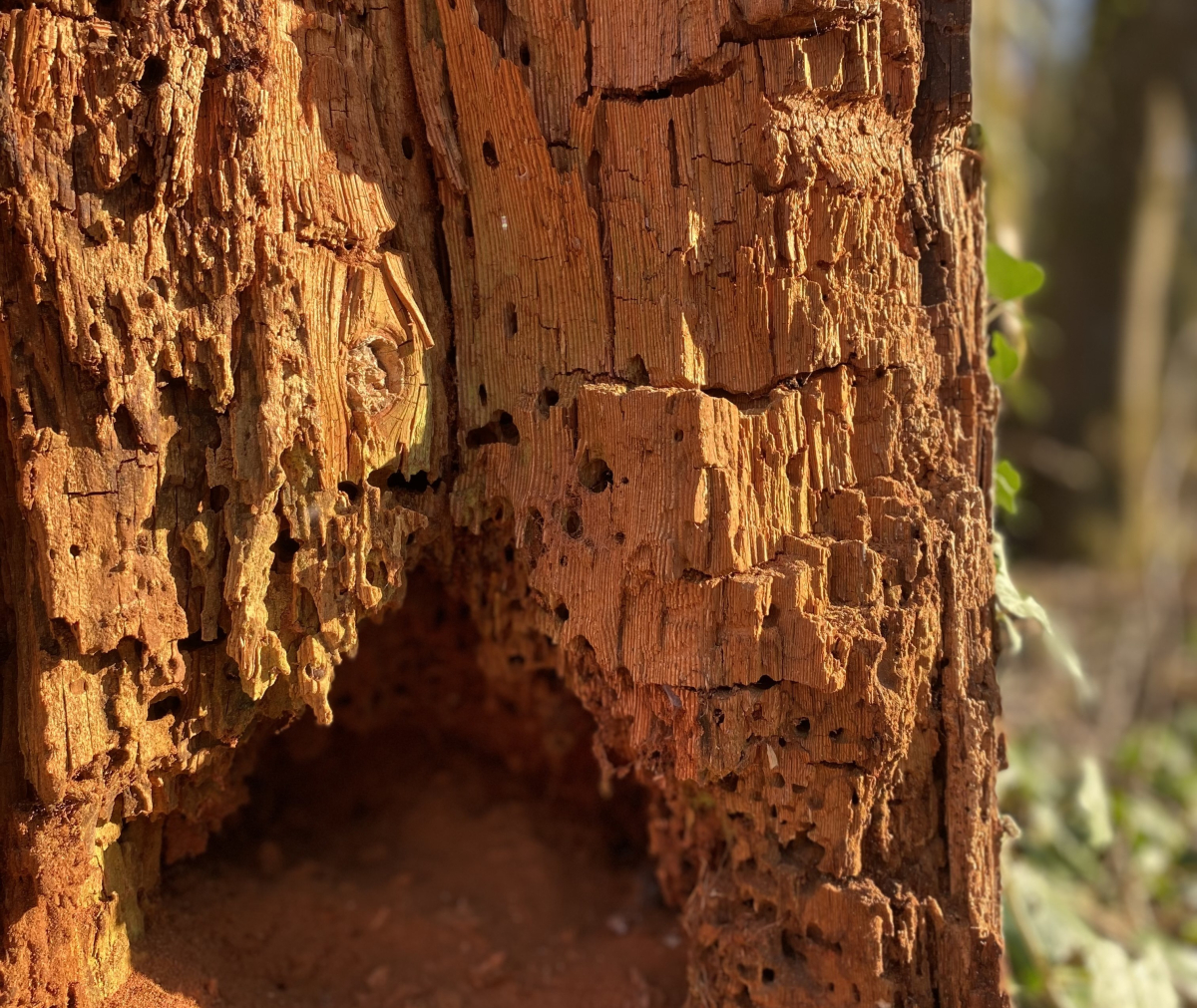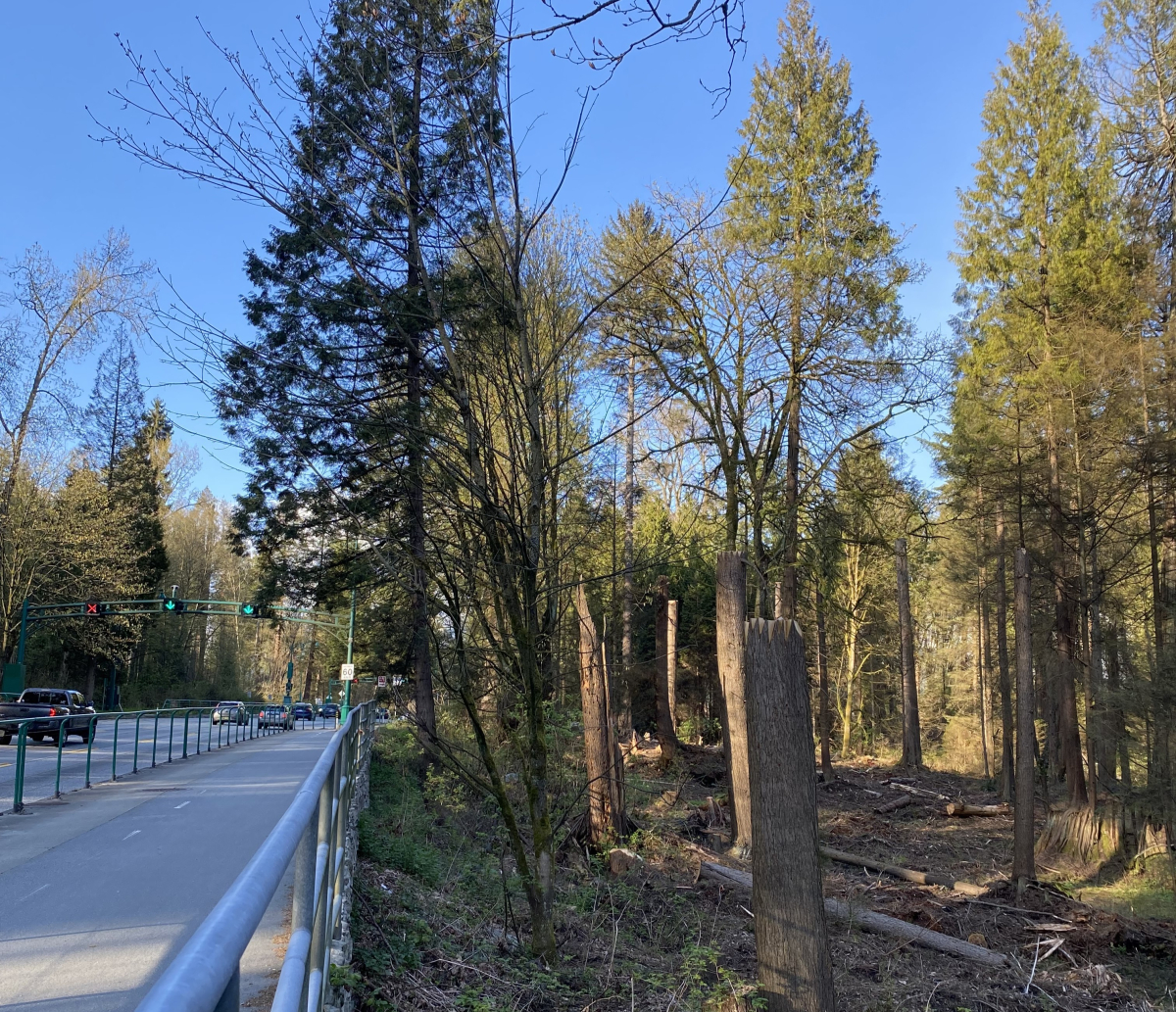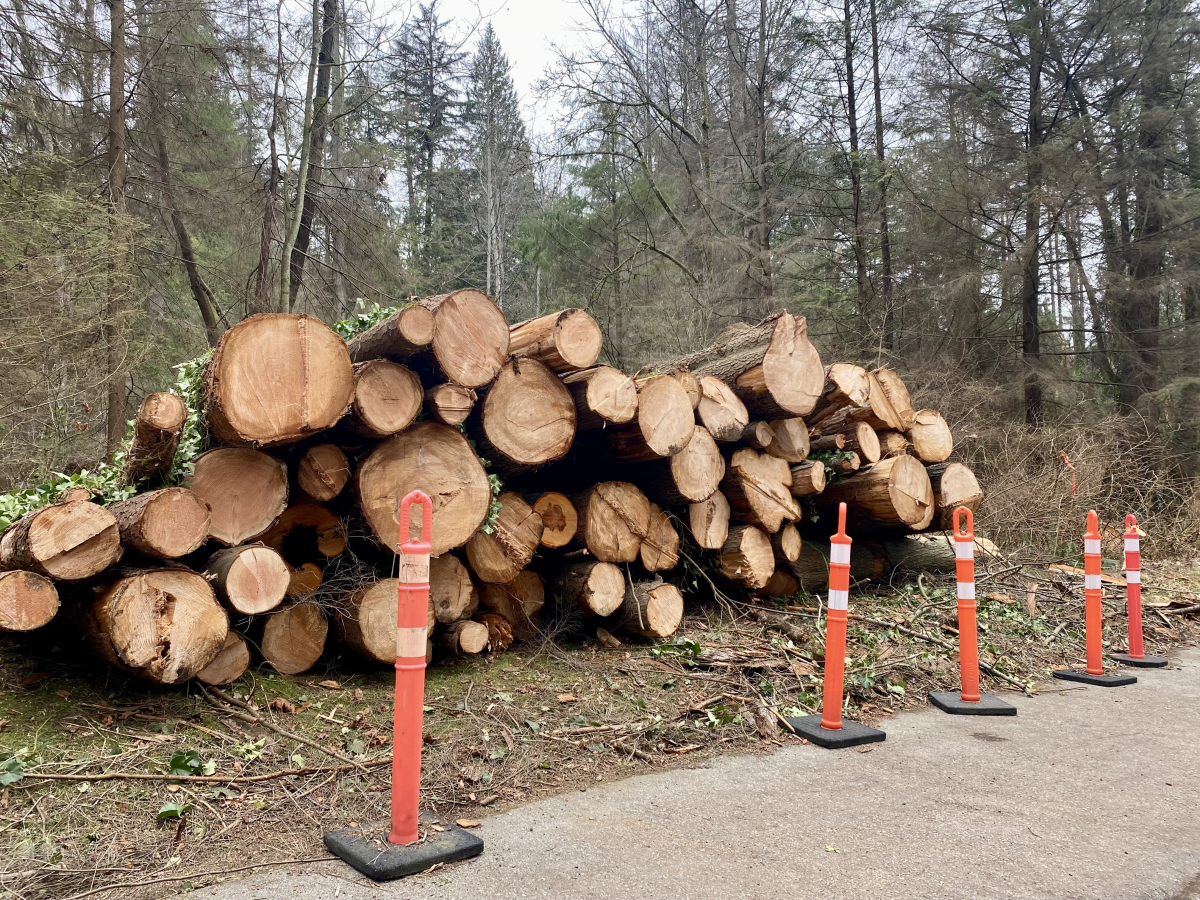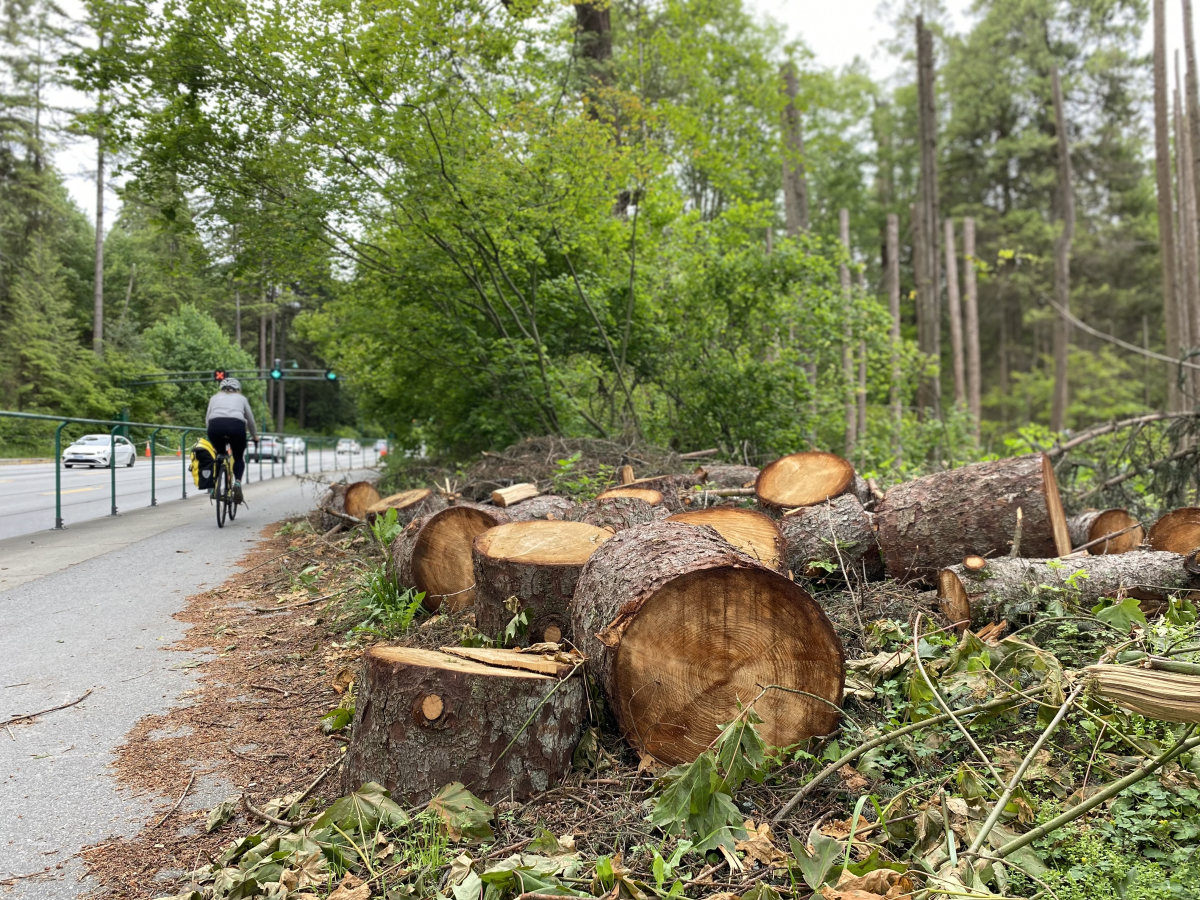Thank you for helping us meet our fundraising goal!
If you walk through Vancouver’s iconic Stanley Park, you may notice the forest feels a little empty. The limb-to-limb wall of evergreens that once dulled city sounds from park-goers is now marred by dead trees, some still standing with brown needles, others cut and stacked in heaping piles along trails.
In October of 2023, the City of Vancouver began a multi-year process to fell 160,000 trees, almost a third of those in Stanley Park, a Vancouver landmark that draws over eight million visitors annually. Most of the dead trees are western hemlocks that fell prey to the western hemlock looper moth, an insect no larger than a Canadian toonie and with a mighty appetite that has been thriving in a changing climate.
“As climate change continues and sadly accelerates, we are seeing more and more impacts on ecosystems,” says Jens Wieting, senior policy and science advisor at the Sierra Club of BC. “It’s becoming more common for species like the western hemlock looper moth to multiply beyond their expected population boom.”
British Columbia is experiencing hotter and drier summers caused by climate change: 2023 was the most destructive wildfire season in the province’s recorded history, with 2024 expected to pose similar challenges.
Wieting says that while some species suffer from the effects of a changing climate, others are exploding in numbers – at least in short bursts. “The lack of really cold winters means that some, like in past years the mountain pine beetle, and now the western hemlock looper, will survive in great numbers and reemerge even stronger in the spring and continue to feast on some of the trees,” he says. The strengthened outbreak is now toppling Stanley Park’s century-old trees.
Stanley Park’s new neighbour
The western hemlock looper is a familiar sight in B.C. Its larvae hatch in spring, pupate over the summer, and transform into adult moths by the fall.
At every part of its lifecycle, the moth is harmful to western hemlocks: its larvae burrow into and feed on host trees, while the moths themselves eat tree leaves and needles, resulting in high mortality levels for heavily defoliated hemlocks, according to the B.C. provincial government.
“They are really voracious feeders,” says Dr. Gerhard Gries, a professor and researcher of animal communication ecology at Simon Fraser University. Whatever parts of the leaves remain turn red, indicating the start of an infestation, he says.

“They are honing in on Hemlock because it's a tree they are doing best on as larvae,” he says. However, the moth will also settle for western red cedars, interior spruces and Douglas firs.
Looper moths have periodic population booms — or outbreaks. According to Gries, these outbreaks occur in B.C.'s interior every 11 to 15 years and every 20 years on the coast. They usually last three to four years before natural controls, like pathogens, bacteria-induced diseases, or summer rains, disrupt moth flight and regulate the population.
Gries says that the reasons behind these cyclical outbreaks still need to be fully understood and that patterns can shift with changes in weather conditions. “Because Stanley Park had quite a few hemlock, I think it was only a matter of time until the looper would hit those trees,” he says.
Impacts of an outbreak
B.C.’s Lower Mainland, including Vancouver’s 405-hectare Stanley Park, has been dealing with this outbreak for several years.
The outbreak started on the North Shore in 2019 and spread to Stanley Park in 2020, says Joe McLeod, the Vancouver Park Board urban forestry manager. Initially, the impact was minimal. “The guidance we received… was that if there were little enough impact on each tree, then the trees would recover,” McLeod says.
Yet that wasn’t the case. “If we see the outbreak continue this year, it will be year five,” McLeod says.
The 2023 decision to cut down the trees was not just aesthetic. “There was also an increase in wildfire risk,” he says, because the park is full of dead trees and woody debris, both of which are highly combustible and had yet to be cleared.
Dead trees are also prone to falling down in high winds posing a danger to the public. The causeway — a high-traffic road that boasts an annual daily average of nearly 30,000 westbound commuters — would be a particularly dangerous place for a tree to fall, McLeod notes.

In what McLeod calls a “mitigative emergency response,” the City quickly hired forestry consultancy B.A. Blackwell & Associates Ltd. to deal with the infestation’s destruction and reduce wildfire risk.
Blackwell & Associates issued a risk assessment report to the City in January 2024, indicating that 24 per cent of Stanley Park is classified as a high and extreme wildfire risk, with an additional 60 per cent classified as moderate risk.
Roughly 30 per cent of the trees greater than 20cm in diameter — older trees — have been “killed or severely defoliated by looper defoliation” as of April 2023, the report reads. An additional 36 per cent have been “moderately defoliated.” Most of the impacted trees are western hemlock, with some Douglas fir and western cedar also affected.
Revitalization efforts are underway. As of April, 25,000 Western red cedar, Douglas Fir, Grand Fir, Pacific Yew, Sitka Spruce, and Red Alder have been planted. The park board hopes this balance of forest species will minimize the risk of future outbreaks.
“We're not planting any western hemlock,” Joe McLeod says.
Was chopping the right call?
McLeod says the City considered other alternatives, including the biopesticide bacillus thuringiensis kurstaki (BTK), before engaging a tree removal company. But the problem with BTK, he explains, is that it’s not selective in the insect species it targets — it would also kill various other species of moths and butterflies.
According to Dr. Gries, the city would have had to use BTK from the start or let nature run its course with “no intervention, no management, no countermeasures.”
Instead, Gries believes “nobody noticed that the population was increasing in size,” which led to the City being “inconsistent” with the recommended measures to treat the infestation.
The City's decision seems like the worst-case scenario for Michael Roberts Caditz, a member of the group Save Stanley Park. He says he has talked to other tree experts and scientists who don’t believe the dead and dying trees posed a significant safety risk.

He and fellow group members circulated a petition that has over 18,000 signatures and says the group is seeking advice on whether it has grounds for legal action.
As it stands, Caditz hopes logging will be temporarily suspended so the opposing views of scientific experts and citizen groups who were not originally consulted can be heard.
Other interested parties in the discussion over what happens to the area includes the xʷməθkʷəy̓əm (Musqueam), Sḵwx̱wú7mesh (Squamish), and səlilwətaɬ (Tsleil-Waututh) First Nations (MST), on whose land Stanley Park rests. McLeod says that the board has been talking to MST since July 2022 about “below-ground and above-ground cultural resources,” he says.
Planting for the future
Forest management is not easy, particularly when it comes to wildfire risk and remediation, says Dr. Danielle Ignace, an assistant professor of Indigenous Natural Sciences at the department of forest and conservation sciences at the University of British Columbia.
“It can take time. It's expensive. It takes a lot of people to do that, as well. So I don't envy them,” she says. “We're all afraid of the upcoming fire season because we are in drought conditions.”
However, Ignace emphasizes the importance of consultation with multiple communities, perspectives, and values when it comes to handling the infestation – and replanting trees.
“I think the Indigenous communities should be really involved in the process of replanting,” Ignace says, suggesting they should be consulted about culturally important species during the replanting process. When asked about planning for future outbreaks, McLeod says there will be another hemlock looper infestation at some point, but that’s what forest management is all about.
“Forests are dynamic environments. Forests aren’t static,” he says, “they're always changing.”
There’s always a risk when it comes to trees, whether it’s wind, lightning, or insects, and it is the City’s responsibility to manage those risks for human safety, McLeod says. But Stanley Park’s ecology was “ripe for a major reset,” he adds, and the opportunity is there to do so now.
However, Ignace hesitates to use the phrase “resetting the ecology” when it comes to replanting. “I don’t think that’s the right way to phrase that on their part,” she says, emphasizing the need to consider Indigenous cultural considerations and climate change in the replanting process.
But until the trees grow back, park visitors will be greeted with a landscape of stumps and fragile saplings. This kind of environmental destruction — the ultimate consequence of climate change — impacts both the park’s appeal and ecology.
“We really have to take these warning signs very seriously,” Wieting says.
As climate change worsens, city planners will face more difficult choices. “It will only get more and more difficult and we have to take action both on fossil fuels and completely changing forest management. And this means that generally, we have to protect more forests, more trees, whenever we can.”






Comments